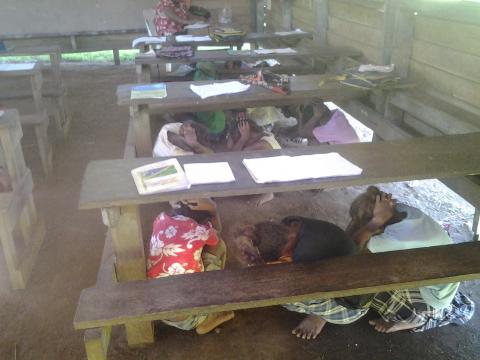Preparing students of Solomon Islands to become disaster preparedness champions

Children in the Solomon Islands are always excited to go to school. It is where they learn about the world around them and enjoy the company of their friends. These experiences lead to fond memories that last a lifetime. But children are also vulnerable to the impacts of natural disasters, when they are far from the protection of their parents, and especially if their school does not have a disaster preparedness and response plan for such situations.
In Makira province, Taripara community high school is one of four schools on the island that is currently engaged with World Vision’s Champions of Tomorrow project, which aims to increase the resilience of school children towards natural disasters and climate change.
The Solomon Islands is consistently rated as one of the most disaster-prone countries in the world. The school is located approximately 300 meters from the seaside and between two river banks, so it is already highly prone to multiple impacts of natural disasters such as earthquakes, tsunamis, hurricanes, and flash flooding.
Since the project began implementation in early 2020, Taripara community high school has undergone two disaster response simulation activities for earthquakes, tsunamis, and flash flooding. Having learned a lot about the importance of disaster preparedness and response, the school’s disaster committee wasted no time to identify potential risks and began to develop a plan towards the long term safety of their staff and students.
“It never occurred to us that we needed a disaster preparedness and response plan. We experienced earthquakes and cyclones in the past, but all we did was stand still or run and hide in our houses until it passed,” shared Steven, the head principal of Taripara School.
Steven is also the chairman of the school’s disaster committee, which is responsible for the safety of more than 350 students, most of whom travel 4 to 6 km by foot to get to school.
The school disaster committee’s first priority was to set up a safe environment for staff and students. To do this, they needed support from parents who resided in surrounding catchment communities. Together with the host communities, they began by conducting awareness on the importance of the Champions of Tomorrow project, and their plan to improve the school compound in order to ensure the safety of children when they are in school.
Immediately, the committee received an overwhelming response that saw all the surrounding communities willingly support the committee’s plans and agreed to provide sawn timber for the school with some support from the school for fuel.
Today the school has begun building new staff houses and started to erect a boundary fence around the premises.
“When the staff houses are complete, we will move on to the bigger project, which is to build a student dormitory,” said Steven. We want students to be able to travel less, as most of them live quite far from the school and usually walk to school along riverbanks, sea-sides, and bush roads.” He says the aim is to be able to account for every single staff and student’s safety during a real disaster response. Taripara School has not had any major infrastructural development since early 2000, and the project is a wakeup call for the school and all the surrounding communities especially towards disaster preparation, response, and the overall safety of children in the school.
Supported by the Australian government through the Australian Humanitarian Partnership, World Vision is partnering with Save the Children to implement the Champions of Tomorrow project in 8 schools: 4 in Makira and 4 in Malaita. The project works to achieve its aims through school and community-based activities that equip girls and boys, both with and without disabilities, with the knowledge, skills, and confidence to meaningfully lead Disaster Risk Reduction (DRR) and Climate Change Adaptation (CCA) activities, with guidance and support from teachers, families and communities